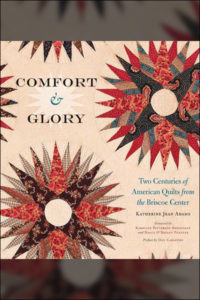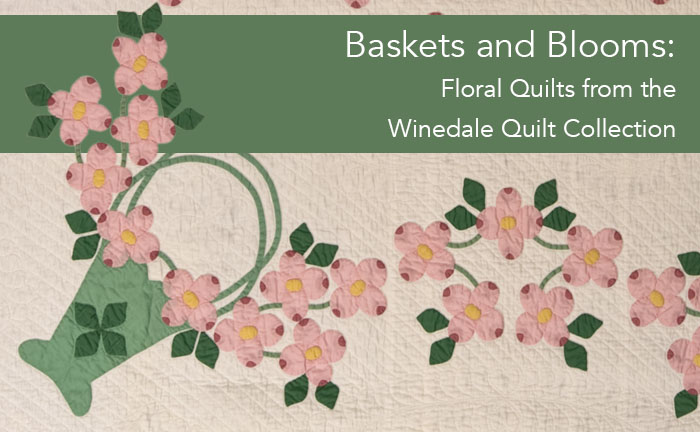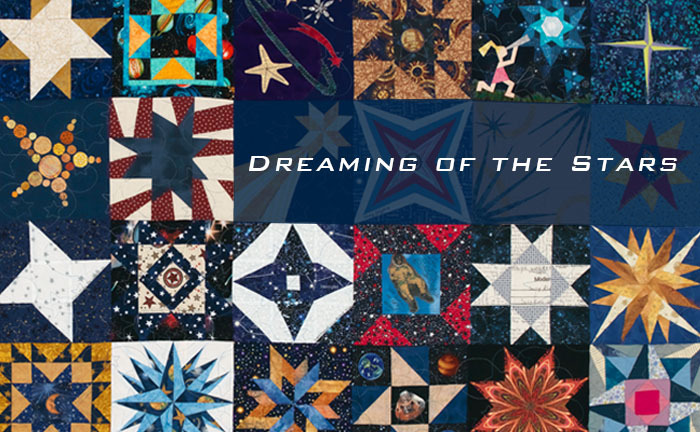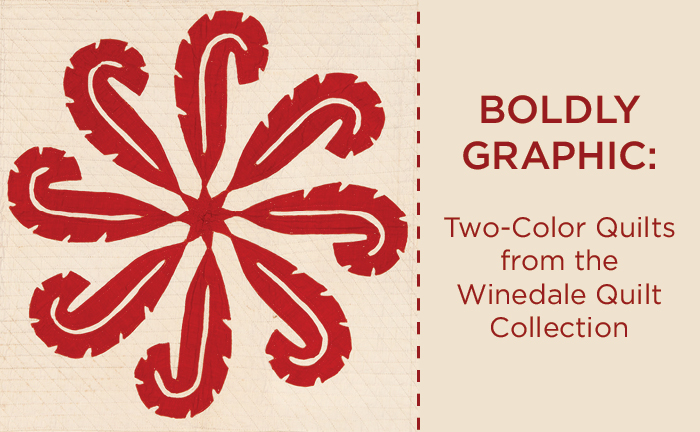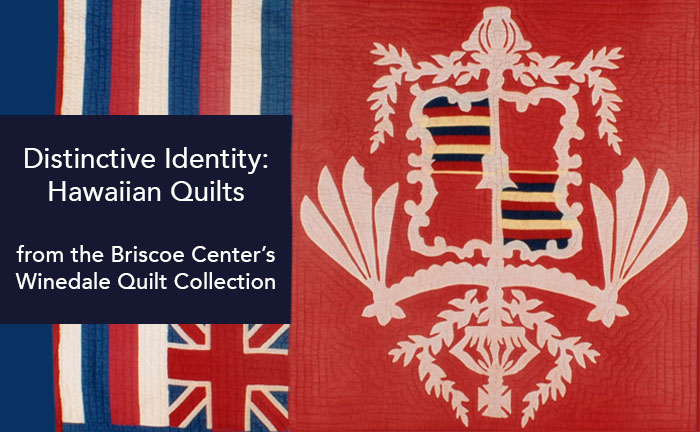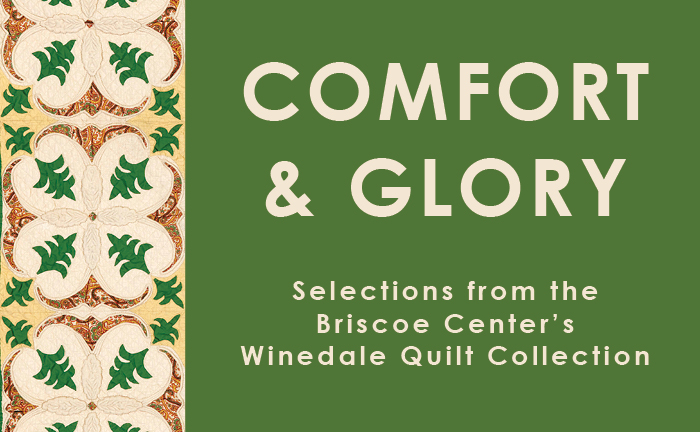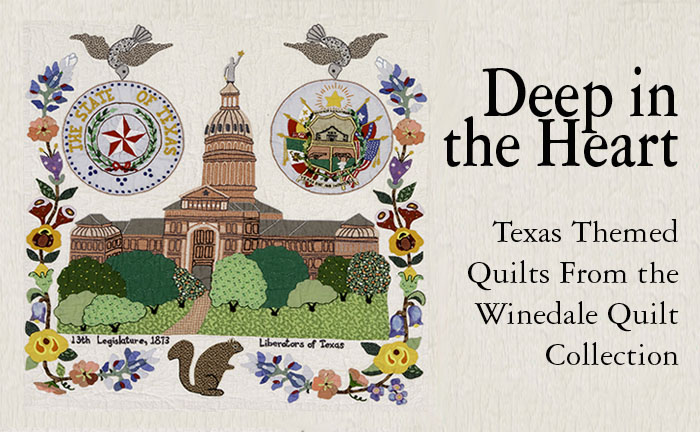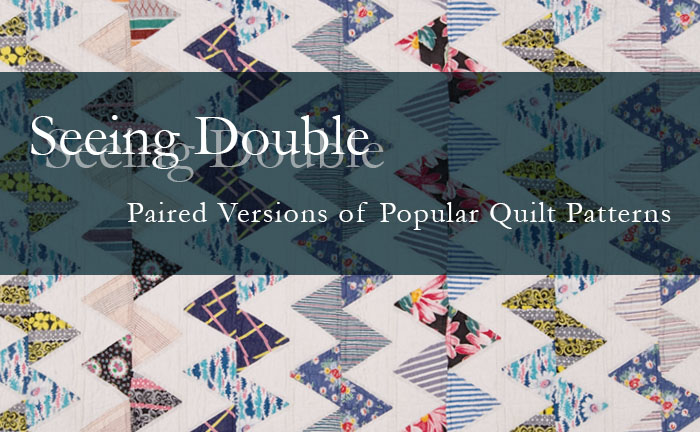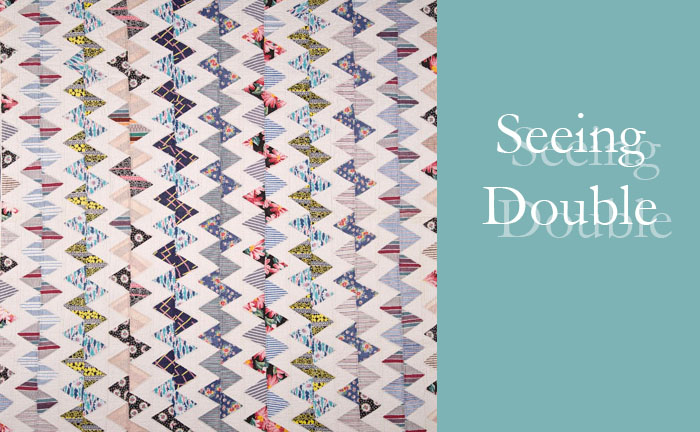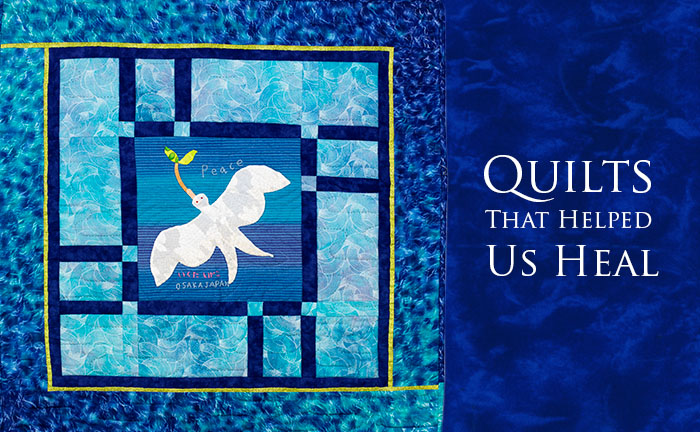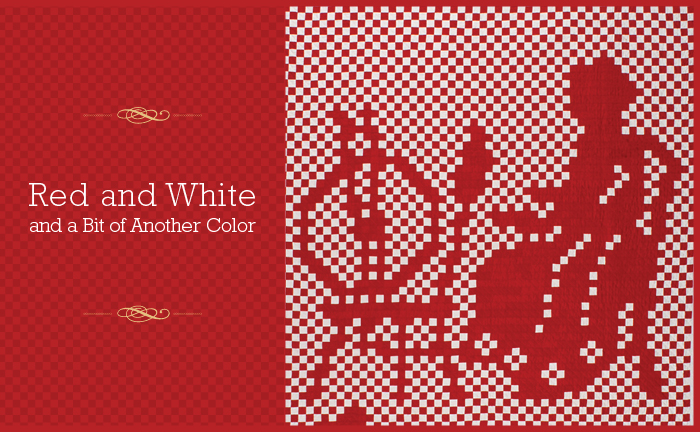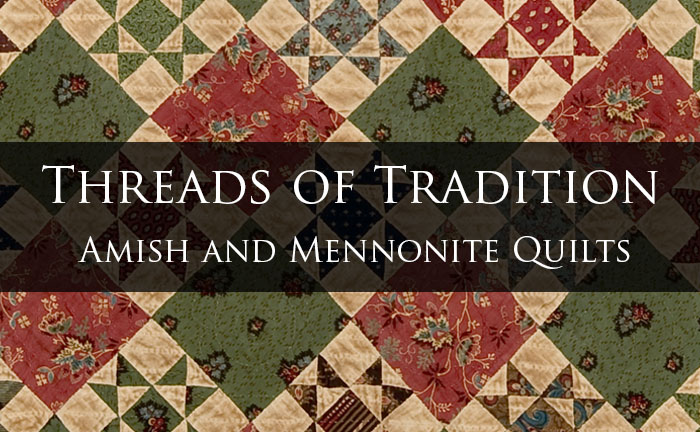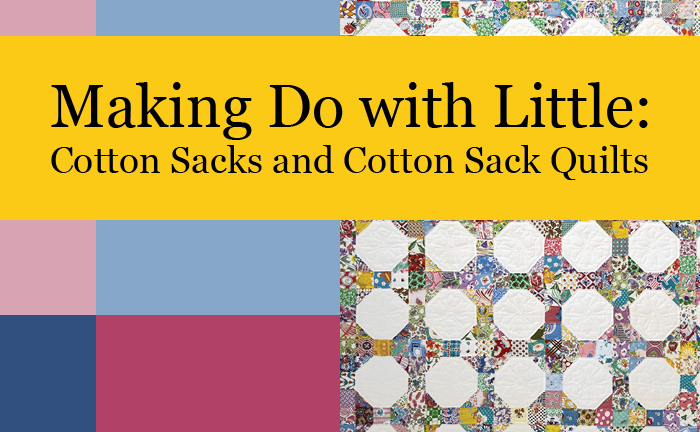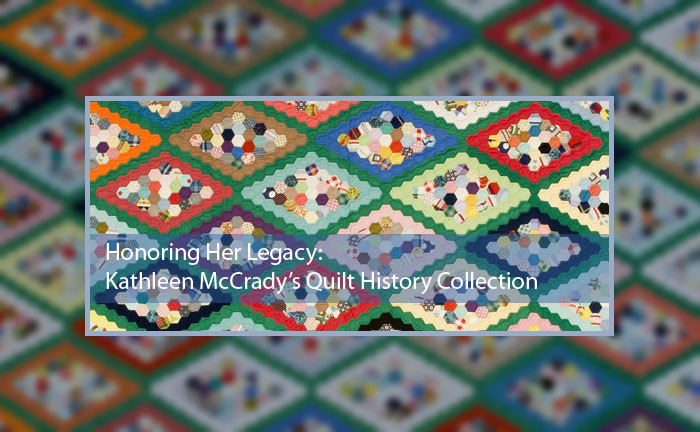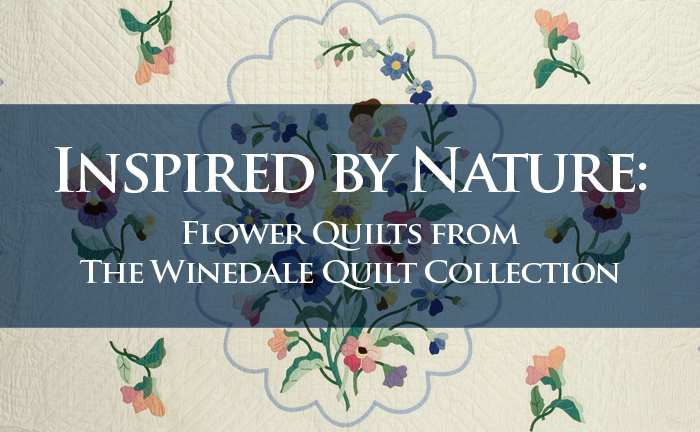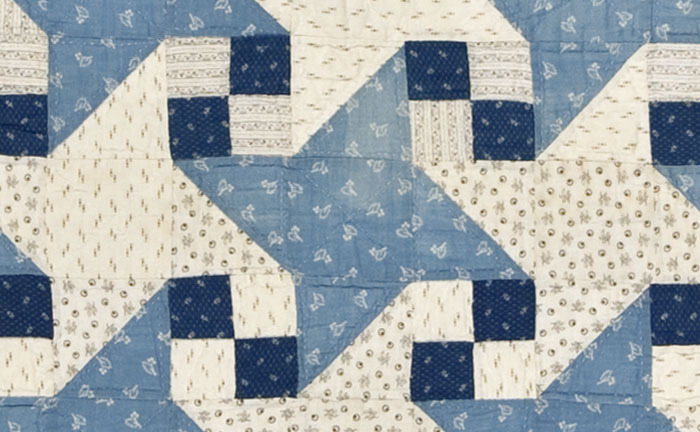Quilts delight us with their fabrics, colors, and patterns, and produce comfort from their warmth, familial associations, and often collaborative nature. They are also powerful visual storytellers that can speak to the history of migration, racism, colonization, slavery, war, and imperialism within and beyond the borders of the United States. In addition, the skill, imagination, and physical labor evident in the Winedale Quilt Collection illuminates historically marginalized women’s work.
The Winedale Quilt Collection at the Dolph Briscoe Center for American History is a premier scholarly resource that supports the study of quilts and their history. The collection covers a broad range of American quilts with special emphasis on those that were made in Texas or those that were brought to the state during the nineteenth century. The Winedale Quilt Collection contains nearly 900 quilts and spans over two hundred years of quiltmaking. It also features documentary resources that support research into the role of quilts in American culture, especially during the twentieth century.
The foundations of the center’s quilt collections began at Winedale, in Fayette County, Texas. Beginning in the 1960s, the Houston philanthropist and decorative arts collector Miss Ima Hogg assembled at Winedale a group of seventeen quilts as part of the buildings, furniture, decorative objects, and other artifacts that were formally donated to the university in 1967.
Perhaps the most rare of the Ima Hogg quilts is the small Le Moyne Star Crib Quilt, which most likely was sewn in New England between 1830 and 1850. Named for the two brothers who colonized the Natchez Indian territory of the Lower Mississippi River Valley, the quilt top features nine different indigo fabrics plus large-scale floral chintzes; however, the back is what makes the piece truly unique. The fabric is a rare commemorative repeating print of a banner with symbols of military domination and the word TEXAS arching over a Lone Star. It probably was created to celebrate Texas independence in 1836 or, perhaps, the annexation of Texas to the United States in 1845.

Several other quilts also came to Winedale as part of a general swell of donations during Miss Ima’s lifetime and for some years after. Most were donated by area residents who sought a permanent institutional home for their family heirloom quilts.
Winedale Quilt Collection
Shortly after Winedale became a part of the Briscoe Center in 1995, the center began to build on the core quilt collection in an effort to create a resource for the study of American culture, women’s history, textiles, and related fields. Two major supporters in that effort were university alumni Karey Bresenhan and Nancy O’Bryant Puentes, co-founders of the International Quilt Association and prominent members in the growing national and Texas quilt communities. Bresenhan and Puentes were eager to help the Briscoe Center bring greater visibility to its quilt holdings through exhibitions and public programs. They also paved the way for the center’s partnership with the Quilt Alliance, a national nonprofit organization that was established in 1993 to document, preserve, and share American quilt heritage.
The Winedale Quilt Collection covers a broad range of American quilts with a special emphasis on those that were made in Texas or those that were brought to the state during the nineteenth century. The collection contains nearly 900 quilts and spans over two hundred years of quilt making. It also features documentary resources that support research into the role of quilts in American culture, especially during the twentieth century.
Kathleen McCrady Quilt History Collection

By 2000 the stage had been set for the Briscoe Center to actively build its quilt holdings and expand the collection to include documentary materials that support the study of American quilts. The center’s first such acquisition was the Kathleen McCrady Quilt History Collection.
A Texas quiltmaker, collector, and historian, McCrady began donating her collection in 2002, and today it contains more than 65 quilts and quilt tops, plus vintage fabrics, quilt blocks, and her archive of quilt history documentation. McCrady’s collection includes several of her own award-winning and family quilts, plus rarities such as a heavily inscribed friendship quilt that was made in Ohio in 1851. Also included is the unique Tobacco Sack Puff Quilt that rural Texas quiltmaker Effie Roe created in 1935 using 576 Bull Durham tobacco sacks that she dyed, stuffed, and stitched together.
Texas Memorial Museum

Another significant group was acquired in 2003, when the Texas Memorial Museum transferred more than forty quilts to the Briscoe Center. Among those quilts are several nineteenth-century examples that came to Texas with newly married couples or migrating families.
The acquisition also included the historically important Lone Star Quilt, the fascinating story of which is woven into the post-Civil War history of Texas. Eighteen-year-old Amanda Hammonds made the quilt in 1858 in Rusk County, Texas. In 1867 she and her husband, George Linn, sought to emigrate to Brazil with fellow white Texans rather than live under a Reconstruction government. Her quilt survived thousands of miles of travel, a shipwreck, and several days afloat in the Atlantic Ocean. It remained with the family until 1946, when Daisy Linn Chase, Amanda’s daughter, presented the quilt to Governor Coke Stevenson. He then forwarded it to the Texas Memorial Museum in 1947, making it one of the earliest quilt gifts to the university.
Joyce Gross Quilt History Collection
The Joyce Gross Quilt History Collection, which was acquired in 2008, is the center’s largest and most visible quilt and quilt history acquisition. Assembled by one of the nation’s foremost historians and collectors of twentieth-century quilts, the collection includes some two hundred outstanding examples of quilt artistry as well as a history archive of 300 linear feet. Along with the Winedale Collection, the Gross holdings have cemented the reputation of the Briscoe Center as a preeminent archive among quilt scholars and enthusiasts nation-wide.
Two noteworthy gems in the Gross Collection are Pine Eisfeller’s The Garden (1938) and Tree of Life (1939), both of which are counted among the one hundred best American quilts of the twentieth century.
Other national treasures in the Gross Collection include works by Bertha Stenge, who was known as the “Quilt Queen of Chicago”; quilts collected by noted New Jersey collector and historian Florence Peto; and a rare Royal Hawaiian Flag quilt, created prior to Hawaii’s annexation by the United States.
Collection Development
The Briscoe Center continues to carefully build its collection with pieces that strengthen its research value. Among the center’s more recent acquisitions are a small group of quilts from Anita Murphy of Beaumont, Texas, whose Freedom to Dream quilt was the Texas state prize winner in the Statue of Liberty Centennial quilt competition held in 1986. The imagery is a striking example of the mythos of the American Dream. Also of note is the Sherry Cook Quilt Collection, which contains nineteenth- and twentieth-century examples, quilt history documentation, and a large group of study fabrics.
The Reflections on 9/11 Quilt Collection is the result of a three-year, cross-cultural collaborative project that began immediately following the terrorist attacks of September 11, 2001. What started as 139 quilt blocks that were created by Japanese quiltmakers as expressions of sympathy and support ended with forty finished quilts that were completed by quilters in the San Antonio area. The project was a healing experience for the participants. As one quilt-maker wrote, her quilt “symbolized our bond with . . . the Japanese quilters and with all the families who lost their loved ones as a result of the terror attacks on 9/11.”
The Astronomical Quilts! Block Challenge Collection is comprised of 28 quilts made from 2,500 space-themed quilt blocks created by quilters from around the world, each one inspired by NASA astronaut Karen Nyberg, who hand sewed the star quilt block aboard the International Space Station in 2013. International Quilt Festival founders Karey Bresenhan and Nancy O’Bryant Puentes gifted the collection to the Briscoe Center for permanent preservation and research in 2015.

There are silences in the collection as well. Notably absent are quilts designed and created by Black women (and sometimes men), creative expressions of artistry, craft, and utility that have a rich and ongoing history in the United States. To our knowledge the collection contains four quilts attributed to Black creators: two quilts by Laverne Brackens of Fairfield, Texas; one quilt by Lillian Coffee Wren of Blanco County, Texas, and one quilt by Molly Laramore, possibly from Lockhart, Texas, which interprets the pattern, Puss in the Corner. The Briscoe Center acknowledges this significant gap in documenting the American story of quilts, which we plan to rectify with future acquisitions and programming.
Access to the collection
The Winedale Quilt Collection is housed at the Briscoe Center’s facilities in Austin, where it is supported by the center’s extensive research collections in Texas, regional, and national history. The collection is open to all researchers by appointment only at the center’s Research and Collections Division.
Launched in 2005, the Quilt Alliance’s Quilt Index is a national database of more than fifty thousand quilts held in public and private collections. The Briscoe Center supplies the Quilt Index with digital photographs and descriptive data for many of its quilts.
The Briscoe Center began regularly sharing its quilts with the public in 2001, as workshops, seminars, and exhibitions held at Winedale introduced the collection to large and enthusiastic audiences. The annual Winedale Quilt Exhibit, which is held each February, features a display centered on a specific quilt topic such as pattern histories, florals, and cotton sacks.
As public awareness has spread about the Winedale Quilt Collection, the Briscoe Center also has loaned quilts for exhibition at other venues, including Karey Bresenhan and Nancy Puentes’s International Quilt Festival in Houston and Long Beach, California; the Museum of Quilts and Textiles in San Jose, California; and the National Quilt Museum in Paducah, Kentucky. In Texas, the center featured quilts in two major exhibitions at the Bob Bullock Texas History Museum in Austin. Nine of the center’s Ima Hogg quilts were displayed in the 2006 exhibition Miss Ima’s Quilts, and in November 2009, the Briscoe Center debuted a major quilt acquisition with A Legacy of Quilts: The Briscoe Center’s Joyce Gross Collection. The exhibit was a visual feast that spanned more than one hundred years of quiltmaking and was attended by more than thirty-five thousand people.
Adapted from The Collections: The University of Texas at Austin, 2015. Updated 2020.
Our collections inspire our own projects, including books, exhibits, programs, films, and educational materials.
Banner image: Texas Star, 1932. Briscoe-Garner Museum Quilt Collection. Image detail from e_wqh_0468.





